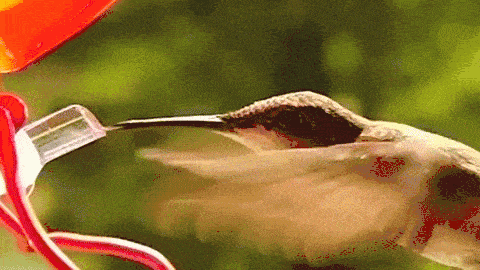Possibly the most hyper animal, the hummingbird, feeds by darting its thin tongue 20 times per second inside the flower to extract the precious nectar. Previously, biologists thought the nectar was being collected through capillary motion. However, after analyzing 18 different hummingbird species while they fed using high frame rate cameras, a group at University of Connecticut found that the fast flapping birds use a totally different way to suck food: the tongue employed as a tiny pump.
The idea that hummingbirds use a “wicking” technique to absorb the nectar can be traced back to 1833. Then, a researcher wrote, “the bird curls its forked tongue into a straw shape, and the liquid is drawn up the tube by surface tension.” But Alejandro Rico-Guevara, a researcher at the University of Connecticut and lead author of the paper, thought the surface tension could keep up with the high licking rate.
Previously, in 2011, Rico-Guevara and colleagues proved that indeed the hummingbirds weren’t using capillary motion to draw nectar. Using high-speed cameras, they showed the bird’s tongue is shaped more like a fork than a capillary tube (try putting a really thin tube inside a water vessel, and you’ll see water climbing inside the tube above the water level without any suction).
“When the hummingbird retracts its tongue from the nectar, these fringes close due to the physical forces of surface tension and Laplace pressure, trapping nectar drops in their grips,” says Rico-Guevara. “Due to this transformation of the tongue shape, the tongue tips don’t remain in the tube-shape necessary for capillary action.”
The tip fork-shaped tongue spreads in an explosive-like manner when dipped in the nectar, but that didn’t explain how hummingbirds sucked the nectar.
In a new trial, the researchers repeated the experiment with over a dozen species. The birds were filmed with high-speed cameras while they sipped from an artificial feeder which mimicked a flower outside and inside.
“What we found is that there is actually a micro-pump, which is transforming the whole tongue shape, and that transformation of the tongue shape is what actually pulls the fluid inside,” Dr. Rico-Guevara said.
“Instead of using vacuum to generate suction—imagine drinking lemonade out of a straw—the system works like a tiny pump, powered by the springiness of the tongue. The bird squashes the tongue flat, and when it springs open, this expansion rapidly pulls the nectar into the grooves in its tongue,” Rico-Guevara writes. “It turns out it’s elastic energy—potential mechanical energy stored by the flattening of the tongue—that lets hummingbirds collect nectar much faster than if they relied on capillarity.”
Besides the empirical evidence, the researchers devised two models: the micro-pump tongue theory and the capillary tube theory. The analysis suggests the micro-pump mode allows the hummingbird to lick faster. In fact, it licks so fast that the snapping movement and pressure generated when the tongue changes shape can suck in the fluid.
The findings appeared in Proceedings of Royal Society B.










